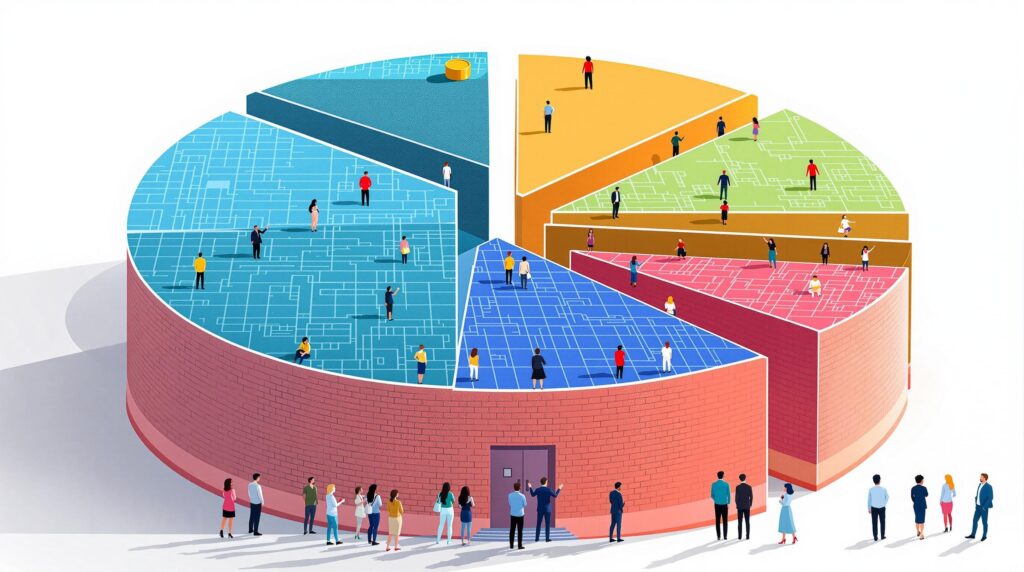[rev_slider alias=”slider-1″][/rev_slider]
Understanding Layer 1 Blockchains: Ethereum, Solana, and Avalanche
When it comes to blockchain technology, Layer 1 blockchains often spark interest due to their fundamental role in decentralized networks. They are like the bedrock upon which entire ecosystems are built. But what exactly makes one Layer 1 blockchain different from another? This section focuses on three major contenders in the Layer 1 arena: Ethereum, Solana, and Avalanche, to understand their significance and contributions to the blockchain universe.
What is a Layer 1 blockchain? A Layer 1 blockchain is the foundation of an entire blockchain network, where its main function is to process transactions and ensure security through its own consensus protocol.
Ethereum: The Pioneer of Smart Contracts
Ethereum is undoubtedly a household name in the blockchain world, often credited with bringing the concept of smart contracts to the masses. Launched in 2015, Ethereum extended the functionality of blockchain technology by enabling developers to build decentralized applications (dApps) on its platform. But what sets it apart from others in the Layer 1 blockchain space?
- Smart Contracts: Ethereum’s ability to execute smart contracts—a set of protocols that automatically facilitate, verify, or enforce the terms of a contract—has revolutionized the way business is conducted online.
- Decentralization: By allowing developers from around the world to build on its platform, Ethereum ensures a diverse and decentralized control of its network.
- Community Support: With a robust community and a widely-supported platform, Ethereum has maintained its position as a leader in the blockchain space.
Ethereum operates using a proof-of-work (PoW) consensus protocol, but it is transitioning to proof-of-stake (PoS) in a massive upgrade known as Ethereum 2.0, aimed at improving scalability and reducing energy consumption.
Solana: The Speed Demon of Blockchains
Known for its incredible transaction speeds, Solana has rapidly gained attention in the blockchain realm. Launched in 2020, Solana was designed with the goal of providing a fast, secure, and censorship-resistant blockchain capable of supporting global adoption.
- High Throughput: Solana claims to process over 65,000 transactions per second, making it one of the fastest blockchains available.
- Unique Consensus: Its unique proof-of-history (PoH) consensus blends seamlessly with proof-of-stake, enabling efficient and reliable transactions.
- Energy Efficiency: Solana’s low energy consumption has become a critical attribute, especially in discussions about the environmental impact of cryptocurrencies.
For blockchain enthusiasts and developers, Solana offers a lucrative platform due to its speed and efficiency, as it aligns with the growing demand for high-performance blockchains.
Avalanche: The Versatile Platform
Avalanche stands out with its focus on solving the common issues of decentralization, security, and scalability, often referred to as the blockchain trilemma. Developed by Ava Labs and launched in 2020, Avalanche aims to be highly adaptable, offering unique advantages compared to its Layer 1 counterparts.
- Consensus Protocol: Avalanche employs the Snowman consensus protocol, designed for near-instant finality and robustness.
- Subnets: It allows for the creation of custom blockchains integrated into its network, known as subnets, enabling tailored solutions and interoperability.
- DeFi Capabilities: Avalanche has become a host to numerous decentralized finance applications, drawing numerous developers to its network.
By leveraging its unique architecture, Avalanche seeks to balance decentralization and performance, making it a significant player in the blockchain landscape. As the blockchain ecosystem continues to grow, understanding these Layer 1 platforms’ roles can pave the way for innovators like Jara to exploit their potential.
“Your investment journey in Africa doesn’t have to be daunting. Through Jara, experience how these blockchains operate to transform assets from local to global with unprecedented ease.”
Each of these Layer 1 blockchains—Ethereum, Solana, and Avalanche—has harvested a dedicated following due to its unique offering. However, the question remains: which will dominate in the African market, particularly for assets and technology like Jara is pioneering? Exploring these networks’ framework uncovers a path for capital to flow efficiently from international investors to the African continent, fostering growth as vast as Africa’s potential.
Comparison of Consensus Mechanisms
Exploring Proof of Stake vs. Proof of Work
The world of blockchain technology is ever-evolving, and at its core are the consensus mechanisms that maintain network integrity. These mechanisms are pivotal for validating transactions and ensuring security. Let’s delve into how Ethereum, Solana, and Avalanche utilize different approaches to consensus: Proof of Stake (PoS) and Proof of Work (PoW).
What is Proof of Work? Proof of Work is a consensus mechanism that requires participants to solve computational puzzles to validate transactions and create new blocks.
Ethereum, traditionally a Proof of Work blockchain, is transitioning to Proof of Stake through its Ethereum 2.0 upgrade. This shift aims to address scalability concerns and reduce the hefty energy consumption associated with PoW. Under PoW, miners compete to solve complex mathematical problems, a process that consumes significant amounts of power.
In contrast, Solana uses a distinct variant of Proof of Stake known as Proof of History (PoH), which efficiently sequences events and transactions, adding a layer to its PoS. This combination not only optimizes speed, making Solana one of the fastest blockchains, but it also ensures enhanced scalability. Solana’s unique approach allows it to process thousands of transactions per second, a stark contrast to PoW systems.
How does Proof of Stake work? Proof of Stake allows validators to propose new blocks based on the number of coins they hold and are willing to “stake” as collateral.
Avalanche adopts another innovative form of Proof of Stake called the Avalanche consensus protocol. This protocol emphasizes low latency and quick finality, ensuring transactions are validated almost instantly. Furthermore, Avalanche’s architecture supports interoperability with other blockchains, a unique advantage in today’s interconnected digital world.
One of the primary reasons for shifting towards PoS from PoW, as seen with Ethereum, involves energy efficiency. Proof of Stake is far less energy-intensive since it doesn’t rely on computational power to the same extent. This not only makes PoS more sustainable but also aligns with the global push towards environmentally-friendly technologies.
- Security Aspects: Both PoW and PoS focus on securing the network, but PoS is often considered more secure due to its defense against various attacks, such as the 51% attack.
- Transaction Speed: Solana and Avalanche, utilizing PoS and its variants, favor higher transaction speeds compared to Ethereum’s current PoW model.
- Scalability Potential: Transitioning to PoS enables networks to handle more simultaneous transactions, addressing one of the major bottlenecks in blockchain systems.
The transition from PoW to PoS is driven by the need for blockchains to maintain scalability, security, and sustainability. Each of these blockchain platforms has chosen its approach based on strategic priorities, future-proofing their value propositions in the market. Whether it’s Ethereum’s ongoing transition, Solana’s innovative PoH, or Avalanche’s rapid consensus protocol, these platforms are pushing the boundaries of what’s possible in decentralized technology.
As the blockchain landscape grows, the emphasis on efficient, secure, and scalable consensus mechanisms will continue to be a focal point. For those invested in or merely following the industry, understanding these mechanisms offers insight into the future trajectory of the blockchain revolution. To delve deeper into the comparison of consensus mechanisms, visit this comprehensive guide.
[rev_slider alias=”text-call-cta”][/rev_slider]
Scalability and Performance Metrics
In the rapidly evolving world of blockchain technology, scalability and performance metrics are crucial for evaluating the efficiency of blockchain networks. As more users flock to decentralized platforms, the need for robust systems that can handle increased demand without compromising on speed and decentralization becomes paramount. Here, we delve into the scalability solutions and performance metrics of Ethereum, Solana, and Avalanche, exploring how each tackles the inherent challenges.
Ethereum: The Pioneer of Smart Contracts
Ethereum, known for ushering in the era of smart contracts, has long been a staple in the blockchain community. However, it faces challenges with scalability. Ethereum’s current version uses a proof-of-work (PoW) mechanism, which, while secure, limits its throughput to around 30 transactions per second (TPS). Such limitations can lead to high transaction fees and slower speeds during peak usage times.
- Ethereum 2.0 and Sharding: To address these issues, Ethereum is transitioning to Ethereum 2.0, which implements a proof-of-stake (PoS) consensus and introduces sharding. Sharding divides the blockchain into smaller pieces, allowing for increased parallel processing of transactions.
- Layer 2 Solutions: In addition to sharding, Ethereum has adopted layer 2 solutions such as rollups and sidechains to enhance scalability by offloading transactions from the main chain.
- Immutable Security: Despite its scalability challenges, Ethereum maintains a strong security framework that minimizes risks of fraud and unauthorized tampering.
What are layer 2 blockchain solutions? Layer 2 solutions are secondary frameworks or protocols built on top of existing blockchains to improve scalability and efficiency without altering the main chain.
Solana: Speed and Scalability Redefined
Solana has made waves with its high-speed processing capability, boasting an impressive figure of over 65,000 TPS. This is achieved through its innovative proof-of-history (PoH) consensus, which reduces the overhead typically seen in blockchain networks by providing a historical record to prove that a transaction happened at a specific moment in time.
- Seamless Integration: Solana’s architecture supports seamless integration with existing platforms, making it a preferred choice for projects needing high throughput and fast settlement times.
- Low Cost Per Transaction: In contrast to Ethereum, Solana offers low transaction costs, making it an attractive option for high-frequency traders and decentralized applications.
- Decentralization and Security: Despite its high speed and low cost, Solana maintains decentralization through a network of independent validator nodes.
Why choose Solana for scalability? With its ability to process thousands of transactions per second at a fraction of the cost, Solana is designed for scalable applications without compromising security or decentralization.
Avalanche: The Avalanche Consensus
Avalanche sets itself apart with its unique consensus protocol, designed to optimize both speed and scalability. By implementing a directed acyclic graph (DAG) structure for consensus, Avalanche manages to achieve sub-second finality while processing thousands of transactions per second.
- Sub-second Transaction Finality: This makes Avalanche ideal for financial applications where speed is critical.
- High Throughput: With its DAG structure, Avalanche can handle massive amounts of transactions simultaneously, rivaling other leading blockchains.
- Scalable Smart Contract Platform: Avalanche supports a highly scalable smart contract platform, making it a popular choice for decentralized finance (DeFi) projects within Africa’s burgeoning digital economy.
How does Avalanche ensure scalability? Avalanche uses a DAG-based consensus protocol that enables it to achieve high throughput and sub-second finality, which are critical for scalable blockchain solutions.
Comparative Overview
| Blockchain | Consensus Mechanism | Transactions per Second (TPS) | Scalability |
|---|---|---|---|
| Ethereum | Proof-of-Work (soon moving to Proof-of-Stake) | ~30 TPS | Layer 2 solutions, sharding |
| Solana | Proof-of-History | 65,000+ TPS | Native scalability without compromising costs |
| Avalanche | DAG-based Avalanche Consensus | 4,500+ TPS | Sub-second finality and high throughput |
Understanding these differences in scalability and performance metrics is essential for investors and tech developers seeking to leverage blockchain technology in Africa’s digital transformation. Each blockchain offers unique advantages that can be aligned with different business models and digital asset needs.
Use Cases and Ecosystem Development
When comparing Ethereum, Solana, and Avalanche, one of the most critical aspects to examine is their application ecosystems. These blockchain platforms are at the forefront of cryptocurrency innovation, with each offering unique strengths in various domains such as Decentralized Finance (DeFi), Non-Fungible Tokens (NFTs), and smart contracts. Here’s a detailed look at how each network’s ecosystem stands out and its potential impact on their adoption in the Layer 1 blockchain arena.
Ethereum’s Versatile Ecosystem
Ethereum is often considered the king when it comes to smart contracts and decentralized applications (dApps). Its ecosystem supports a vast number of projects across diverse sectors:
- Decentralized Finance (DeFi): Ethereum hosts numerous DeFi protocols like Uniswap, MakerDAO, and Aave, which facilitate decentralized trading and lending.
- Non-Fungible Tokens (NFTs): Many groundbreaking NFT projects operate on Ethereum. Platforms like OpenSea allow for the trading of digital art and collectibles.
- Developer Support: With a robust community and extensive developer resources, Ethereum fosters innovation at a rapid pace.
Why is Ethereum a leader in blockchain applications? Ethereum provides a highly flexible and programmable platform, making it ideal for building diverse dApps and smart contracts.
Ethereum’s wide adoption and security have led it to be a preferred choice among developers, despite issues like higher transaction costs. As updates like Ethereum 2.0 unfold, aimed at enhancing scalability, its position could strengthen further.
Solana’s Speed-Driven Advantage
Known for its lightning-fast transaction speeds and lower costs, Solana is emerging as a formidable rival in the blockchain space with features that attract a different set of use cases:
- High-Performance DeFi: Solana hosts high-throughput DeFi applications that benefit from low-latency and cost-efficient transactions.
- Scalability: Solana’s architecture allows for parallel processing, enabling the network to handle thousands of transactions per second.
- Strong Ecosystem Growth: Backed by a vibrant community, Solana actively supports innovative projects through hackathons and grants.
How does Solana ensure fast transactions? Solana’s unique architecture leverages Proof of History and parallel transaction processing to achieve unparalleled speed.
Solana’s emphasis on scalability and performance has made it a preferred choice for applications requiring high-speed transaction throughput. However, its relatively younger ecosystem and lesser adoption than Ethereum pose challenges that it needs to navigate.
Avalanche’s Flexibility in Customization
Avalanche offers a unique proposition with its focus on allowing custom blockchain networks. Here’s how its ecosystem stands out:
- Modular DeFi Solutions: Avalanche’s platform supports flexible DeFi solutions with efficient interoperability across different blockchain networks.
- Subnetworks: The Avalanche network enables users to create their own customizable blockchains tailored to specific requirements.
- Rapid Settlements: With near-instantaneous transaction finality, Avalanche is designed to support high-volume trading environments.
What makes Avalanche’s ecosystem unique? Avalanche’s ability to support customizable blockchain networks offers flexibility for diverse DeFi projects and NFT marketplaces.
Avalanche’s ecosystem is particularly appealing to businesses and developers looking to build custom solutions with specific regulatory or operational needs. Its technology continues to mature, and as it expands its developer base, its ecosystem could increasingly challenge established networks.
Comparing the Ecosystems
While all three platforms bring something unique to the table, their individual strengths cater to different needs within the blockchain space. Ethereum’s deep-rooted ecosystem and developer support make it ideal for complex applications and smart contracts. Solana’s speed and efficiency market it as the go-to for projects demanding high throughput, and Avalanche’s customizable networks make it a strong contender for tailored blockchain solutions.
A closer look at these ecosystems suggests that the ultimate choice often depends on specific project needs and priorities:
- For Low-Cost Transactions: Solana is unmatched in its low fees and high-speed transactions.
- For Established Infrastructure: Ethereum offers the most mature ecosystem with the broadest developer tools and applications.
- For Custom Blockchain Networks: Avalanche provides the best environment to deploy specialized blockchain applications.
As blockchain technology continues to evolve, so will these ecosystems, further influencing global adoption patterns. How they grow and adapt to new technological advancements will play a crucial role in determining their dominance in the Layer 1 blockchain landscape.
[rev_slider alias=”schedule-consultation-btn”][/rev_slider]

How does blockchain scalability affect transactions?
Blockchain scalability directly impacts the speed and efficiency of transactions. Scalability solutions aim to increase the number of transactions a blockchain can process per second, addressing issues with network congestion and transaction costs.
Scalability in blockchains refers to the ability to handle increased transaction loads. Without proper scalability, blockchains like Ethereum may experience slow transaction processing and high fees.
What are the environmental impacts of Layer 1 blockchain technologies?
Layer 1 blockchains such as Ethereum have significant environmental impacts, primarily due to energy-intensive consensus mechanisms like Proof of Work. The shift to alternatives like Proof of Stake aims to reduce these effects by lowering energy consumption.
The environmental impacts of Layer 1 blockchains are predominantly influenced by their consensus mechanisms, with Proof of Work being notably energy-intensive.
How does decentralization challenge the adoption of blockchain technology?
Decentralization is a core strength of blockchain technology but also presents challenges like slower transaction speeds and governance complexities. These factors can hinder widespread adoption as compared to more centralized solutions that offer simplicity and speed.
Decentralization challenges blockchain adoption by complicating governance and slowing transaction speeds, despite enhancing security and transparency.
In what ways are Layer 2 solutions enhancing Layer 1 blockchains?
Layer 2 solutions improve Layer 1 blockchains by offering enhanced scalability and reduced transaction costs. These solutions operate on top of Layer 1 networks, enabling off-chain transactions and relieving congestion.
Layer 2 solutions enhance Layer 1 blockchains by facilitating off-chain processing, which reduces transaction costs and alleviates network congestion.

Related Pages
Explore more topics that delve into the fascinating world of blockchain, perfect for enriching your understanding of this rapidly evolving field.
| Ethereum Overview | Solana Ecosystem |
| Proof of Stake Explained | Blockchain Performance Metrics |
| DeFi Applications | NFT Marketplace Insights |
| Understanding Smart Contracts | Decentralized Platforms |
Discover What Our Clients Are Saying
At the heart of our commitment to Layer 1 and Layer 2 blockchain solutions is the satisfaction of our clients. We strive for excellence in every case, as reflected by the positive feedback we receive from those we serve.

[rev_slider alias=”slider-3″][/rev_slider]
[rev_slider alias=”slider-6″][/rev_slider]
Your Trusted Experts in Blockchain Solutions
At Jara, we specialize in cutting-edge Layer 1 and Layer 2 blockchain solutions. Whether you’re curious about Ethereum, Solana, Avalanche, or expanding into Layer 2, we’re here to guide you every step of the way. Our team brings deep expertise and a personal touch to ensure your blockchain endeavors are successful and secure.
“Empowering your blockchain journey with tailored solutions and dedicated support.” – Our Jara Promise
Reach out to us today using the links below to discover how we can support your next big move in the blockchain industry.
- Award for Blockchain Innovation in Africa 2023: Tech Innovation Awards, recognized for driving blockchain advancements in African markets.
- Recognized as a Leading Blockchain Solution Provider: The Blockchain Leaders honored us for 2023.
- Excellence in Blockchain Ecosystem Development: Global Tech Awards, 2023 nomination for enhancing blockchain ecosystems.
- Best Emerging Blockchain Application Developer: App Developer Awards 2023, for innovative solutions in blockchain applications.
- Highlighted Among Top Blockchain Advisors: Advisory Excellence Awards, for 2023.
Discover more about our services and offerings by downloading the Jara app for Android or the Jara app for iPhone. Unlock the potential of blockchain technology with Jara, your trusted partner.
Chinyere “Chi” Nnadi Bio
Founder and CEO, Jara | Blockchain Specialist
Content Reviewed by Chi Nnadi and his Content Team. Chi is an experienced entrepreneur dedicated to transforming Africa’s financial ecosystem through blockchain technology. As Founder and CEO of Jara, he builds enterprise-grade infrastructure converting illiquid African assets into globally accessible digital tokens. With his proprietary Layer-2 blockchain technology, Chi bridges the gap between global investors and Africa’s growing digital asset market.
Our Content Review Process
Chi Nnadi along with Jara’s dedicated content team, pledge to offer top-notch material. Our content guidelines ensure thoroughness, reputable sources, unbiased scrutiny, among other quality metrics. Please let us know if there is anything you believe to be inaccurate.
















